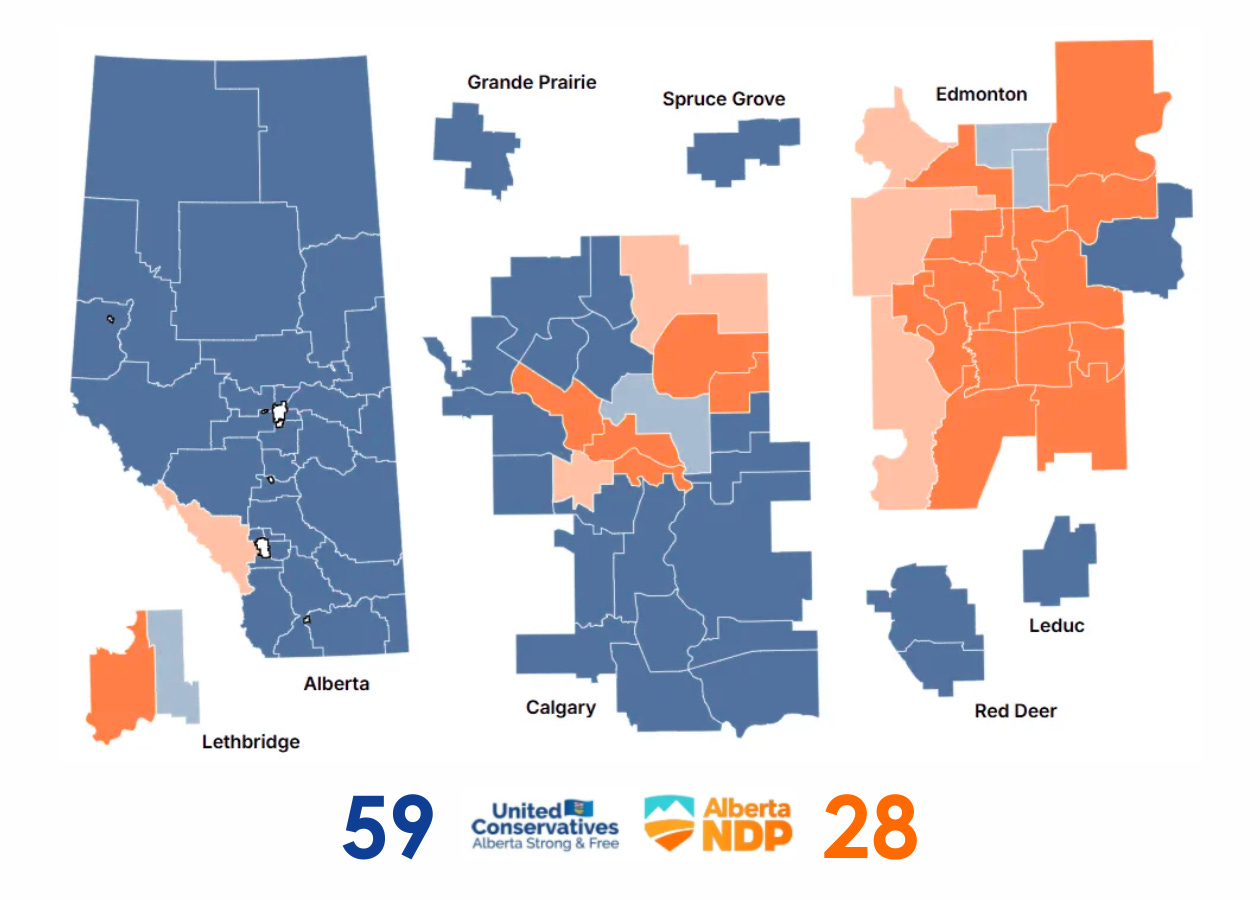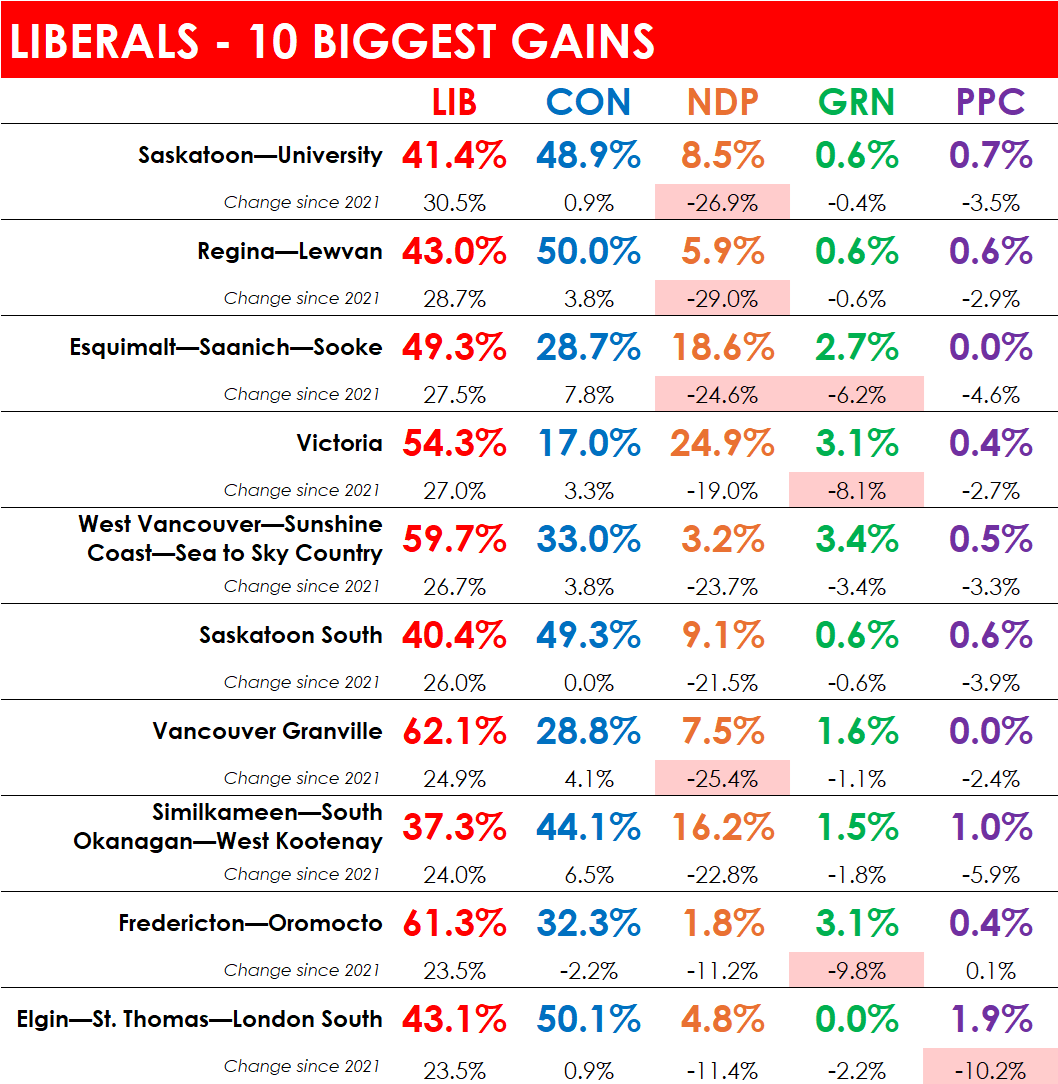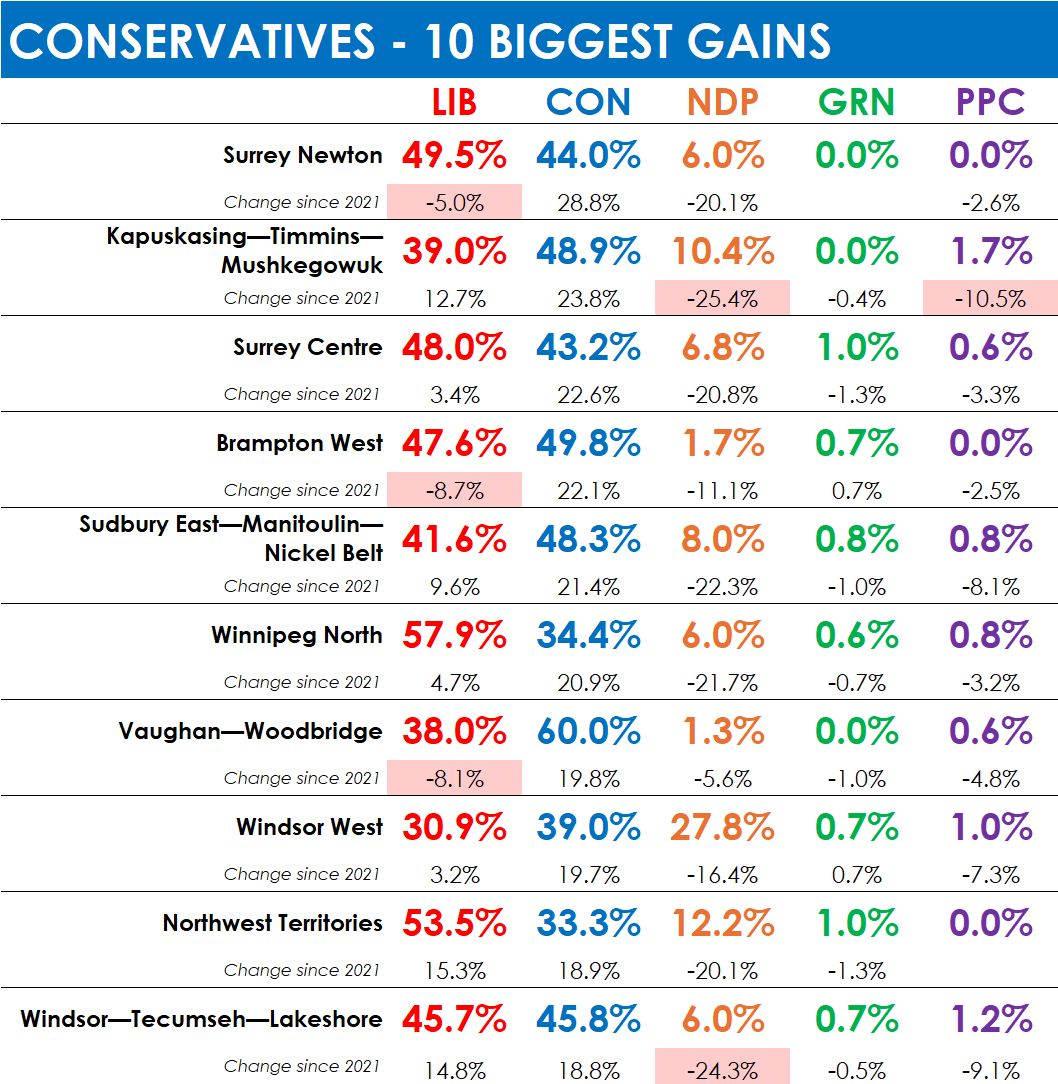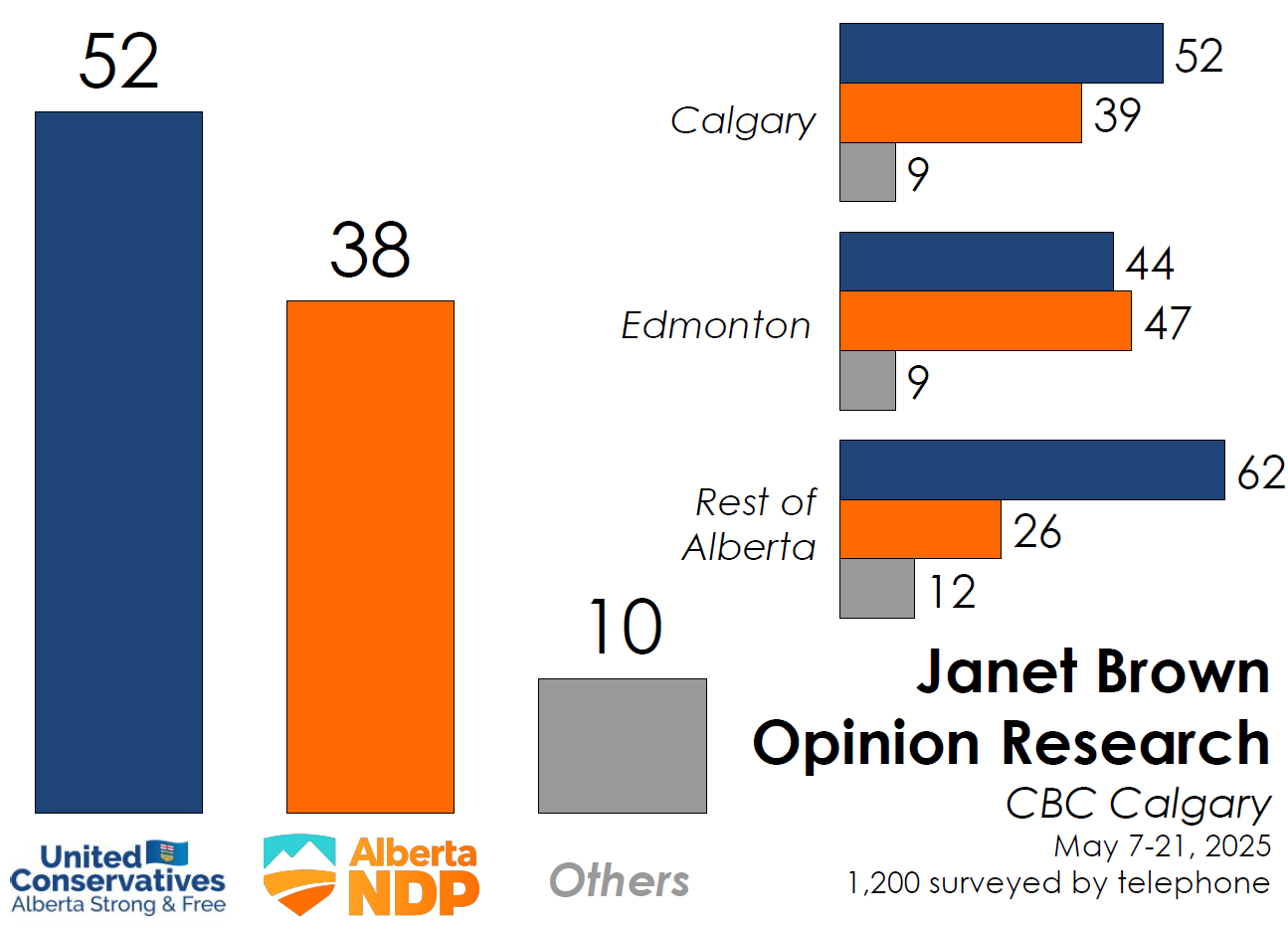Weekly Writ 6/5: Alberta politics under the spotlight
Plus, one last (final, I promise!) look at the 2025 results.
Welcome to the Weekly Writ, a round-up of the latest federal and provincial polls, election news and political history that lands in your inbox every Thursday morning.
The Weekly Writ is back!
The election campaign, of course, pushed it aside and for the last few weeks I’ve been doing some deep dives on each region of the country. But now your weekly update on all the latest electoral and polling trends is back (on Thursday mornings). Still, before putting the 2025 federal election to bed entirely, I wanted to take one last look at some of the results — focusing in on the ridings where the Liberals and Conservatives saw their biggest gains and losses compared to the 2021 election.
We’ll start with the Liberals. The chart below shows the 10 ridings in which the Liberals had their biggest increase in vote share (compared to the transposed results of the 2021 election onto the current map). The drops of other parties highlighted in pink represent losses that ranked in the top 10 worst performances for those parties.
The Liberals’ biggest gains were concentrated in Saskatchewan and British Columbia, with only those ranked ninth and tenth on the list being from elsewhere in the country. The Liberals experienced huge gains in Regina and Saskatoon (not enough to win them anything) and in and around Victoria (which was enough to win them two seats). They also had some big jumps near Vancouver and in the B.C. Interior, as well as in Fredericton and southwestern Ontario.
Interestingly, none of these top 10 show significant drops in Conservative support. This suggests that there wasn’t much transference of vote from the Conservatives to the Liberals. Instead, six of these 10 ridings featured among the worst results for the NDP and Greens. The Liberals made some of their most stellar gains thanks to a transference of votes from progressive parties.
The Conservatives, on the other hand, did make some gains at the expense of the Liberals. The chart below shows the ridings where the Conservatives made the biggest gains. Three of them were among the worst 10 ridings for the Liberals and another two of them were among the worst for the NDP. In some ridings, particularly in the more-diverse portions of the GTA, the Conservatives took votes from the Liberals. In other ridings, such as in Northern Ontario and in Windsor, the Conservatives took votes from the NDP (and, to a lesser extent, the PPC).
It seems clear that the Conservatives made the most inroads among two chunks of the electorate: South Asian Canadians and working class voters.
If we focus on the 10 ridings where the Liberals and Conservatives had their biggest losses, a few things stand out. For the Conservatives, it’s that they lost some ground in the Quebec City area as the Liberals made gains.
The drops in Richmond–Arthabaska, Carleton, Acadie–Annapolis and Abbotsford–South Langley look likely to have been influenced by the names on the ballot or the local factors at play. Recall that Richmond–Arthabaska had been the seat of Alain Rayes before he left the Conservative Party, Abbotsford–South Langley was where former B.C. Liberal cabinet minister Mike de Jong ran as an Independent after he was rejected as a Conservative candidate, and Carleton was Pierre Poilievre’s riding.
For the Liberals, eight of their 10 worst ridings were in and around Toronto, and particularly those with significant visible minority populations. Mount Royal, Thornhill and York Centre are among those with the largest Jewish populations.
The story of where the Liberals and Conservatives traded votes, and where they each benefited from the collapse of the NDP, is clear enough. But what will it mean for the next election? We’ll have to monitor whether or not this was an ephemeral trend or something that could stick around for more than one campaign.
The first Weekly Writ of the month is free to all subscribers. If you’d like to receive full access to the Weekly Writ every Thursday and aren’t already a paid subscriber, please consider upgrading your subscription!
Now, to what is in this instalment of the Weekly Writ:
A preview of what to watch in some upcoming Alberta byelections, plus the PEI Greens choose a new leader.
Danielle Smith’s UCP leads in Alberta and would win another majority if an election were held today, according to a new poll. Also, fresh polls give us a glimpse on where things stand federally and how the premiers are viewed from coast to coast.
The #EveryElectionProject is back with a new instalment, this time on the Manitoba Liberal leadership race of 1993.
Upcoming milestone for Wab Kinew.
NEWS AND ANALYSIS
Alberta byelections to test Smith, Nenshi
A trio of byelections in normally safe ridings will nevertheless mark some important tests for Alberta Premier Danielle Smith and Naheed Nenshi, leader of the Alberta NDP.
The byelections will be held on June 23 in the ridings of Edmonton-Strathcona, Edmonton-Ellerslie and Olds-Didsbury-Three Hills. The average margin of victory in these three ridings was 48 points in the 2023 provincial election, so these are not normally ridings that come with a lot of suspense on election night.
But an independence referendum has a way to concentrate the mind.
For starters, just how well is the NDP doing under Nenshi? The contests in the two Edmonton ridings will give us some clues.
Edmonton-Strathcona was Rachel Notley’s old riding and, accordingly, is the safest NDP seat in Alberta. She won with 80% of the vote in 2023. The UCP candidate finished with just 17%. The riding has been held by the New Democrats since 1997 and only once since 1986 has the party ever failed to win in Strathcona.
Nenshi is using this byelection to try to get into the legislature and there is no doubt that he will be successful. But he can’t escape comparisons to Notley. Will he be able to match or even approach Notley’s 80%? Her worst performance since the NDP became an actual contender for government came in 2019, when she still managed 72% support. If Nenshi cannot clear the bar of 70%, it will raise some questions about how warmly he is being welcomed in NDP-land.
The NDP’s chances of holding Edmonton-Ellerslie are a little bit more in doubt. The byelection comes after the resignation of Rod Loyola, who wanted to run for the federal Liberals. They didn’t approve his candidacy and so Loyola was cast adrift (he got 4.7% as an Independent in Edmonton Gateway) and now the Alberta NDP has to defend this seat.
The party won here with 62% in the 2023 election, beating the UCP by 25 points. While the recent Janet Brown Opinion Research poll (discussed below) suggests the NDP has taken a hit in Edmonton, the swing toward the UCP hasn’t been strong enough to flip a seat like Edmonton-Ellerslie. But byelections can be strange animals, and again the margins might be as telling as who actually wins. A drop in Strathcona and a tight margin in Ellerslie will not bode well for Nenshi, even if the NDP successfully defends both of its seats.
And then there is the byelection in Olds-Didsbury-Three Hills, undoubtedly the most interesting contest of the trio. Nathan Cooper, named Alberta’s representative in Washington, D.C., won this rural riding nestled between Calgary and Red Deer with 75% of the vote in 2023. The NDP finished a distant second at 19%.
But it’ll be the score of the fledgling Republican Party of Alberta that will be the one to watch.
The Republicans are the standard-bearers of the Alberta independence movement (or, at least, would like to be) and are running candidates in all three of these byelections. But Olds-Didsbury-Three Hills is the historical heartland of the separatist movement in Alberta and should be the focus for the Republicans. It was in the riding of Olds-Didsbury that the Western Canada Concept, a party promoting independence for Western Canada, scored its one and only victory in a 1982 byelection. Even in the last election — when no one was seriously talking about separation — the Independence Party of Alberta managed 5% of the vote in Olds-Didsbury-Three Hills.
Winning this seat is probably out of the question for the Republicans. But how much of the vote can they garner? Anything below 10% will suggest the Republicans aren’t serious. Anything between 10% and 20% will raise some eyebrows. Anything about 20% will suggest that there are some real votes behind this push for independence.
It’ll be a shock if the results of these byelections are anything other than two NDP victories and one for the UCP. But that doesn’t mean the stakes aren’t high.
ELECTION NEWS BRIEFS
The PEI Green Party will select its new leader on Saturday. Peter Bevan-Baker, who led the party to official opposition status in the 2019 provincial election, resigned shortly after the Greens were reduced to two seats in 2023. The two candidates for the post are former MLA Hannah Bell and current MLA Matt MacFarlane, whose byelection victory in 2024 boosted the Greens to three seats, tied with the Liberals in the 27-seat Legislative Assembly. All three parties in the legislature, including the governing PCs, are without permanent leaders.
POLLING HIGHLIGHTS
Smith’s UCP holds wide lead over Alberta NDP
New polling by Janet Brown Opinion Research for CBC Calgary suggests that, while Alberta sovereignty is not a popular option, Danielle Smith has not been negatively impacted by putting it on the table and opening up the possibility of a referendum on independence in the short-to-medium term.
The survey had two segments, one being on voting intentions. This portion found the UCP leading with 52% support in Alberta, on par with how the party performed in the 2023 election. The NDP scored 38%, down six points from that last vote. The remaining 10% said they would vote for another party or did not specify which party they would vote for — an almost-certainly inflated number as only 3.3% of Albertans voted for a party other than the UCP or the NDP in the last election (and the moribund Alberta Liberals were the favourite option among the ‘others’ in the JBOR poll).
The UCP led by 13 points in Calgary, indicating that the gap has widened by nine points since the last election. The NDP was ahead by just three points in Edmonton, a city it won by 17 points back in 2023. The UCP had a wide lead in the rest of the province.
The numbers suggest that Smith has been able to hold together the electoral coalition that gave her a majority last time, and that Naheed Nenshi has not moved the party forward in either Calgary (where he was mayor) or in Edmonton.
Using a uniform regional swing model, this poll would result in the UCP winning 59 seats to just 28 for the NDP. The map below shows which seats each party would win, with the paler ridings indicating margins of less than five percentage points. Only four of the UCP’s 59 seats would be decided by less than five points using this model, an indication that they would be in little danger of falling below the threshold of 44 seats needed for a majority government.

The JBOR poll gauged Albertans’ views of the leaders, asking respondents to rate Smith and Nenshi on a scale of 0 to 10, with 0 being “not at all impressed” and 10 being “very impressed”.
On average, Smith scored 4.7 to Nenshi’s 4.1. There were roughly even numbers of Albertans who scored Smith between 7 and 10 (40%) and those who scored her between 0 and 3 (41%). Among UCP supporters, 76% put her at the higher end of the scale.
Nenshi appears to be more of a ‘meh’ for people. Roughly the same share said they were unimpressed by him as they were by Smith (40%), but only 27% rated him between 7 and 10, meaning a larger chunk of respondents put him in the middling 4 to 6 range. This was also the case among NDP voters, with only 64% rating him highly and 3% at the low end.
This could indicate that Nenshi has room to grow if he can impress those in the middle of the road, but he’s turning off as many voters as Smith. His time as mayor of Calgary does not seem to be helping, as his net numbers were better in Edmonton.
The JBOR poll also asked about separation, finding that only 28% of Albertans would vote for separation and 67% would vote against. There are few fence-sitters on this question, so the prospects for the ‘Yes’ side to whittle down that 67% might be slim.
There is definitely a rural/urban split (72% of urban and suburban Albertans would vote against, compared to just 54% in rural areas), but the biggest split is the partisan divide. While 98% of NDP voters would vote against separation, 54% of UCP voters would vote for it, with just 39% voting against it. Smith is leading a party that, while not separatist itself, has a base that is majority separatist. That puts her in an awkward spot, to say the least.
Support for sovereignty among respondents who said they would vote for another party was just 13% with 84% against, suggesting that the UCP does not yet have a viable competitor among the pro-independence electorate.
POLLING NEWS BRIEFS
Two polls suggest that voting intentions have not shifted dramatically since the federal election, with Nanos Research putting the Liberals ahead of the Conservatives at 42% to 36% and Spark Insights finding the Liberals ahead by one point, 41% to 40%. It’s a little too soon to pay too close attention to these movements in the polls, but it is worth noting that Nanos gave Mark Carney a 19-point lead over Pierre Poilievre on the preferred prime minister question, a significantly wider gap than the Liberal Party enjoys over the Conservatives.
According to Pollara Strategic Insights, Doug Ford is the best-known and best-liked premier among all Canadians, though he is more appreciated outside of Ontario than inside the province. The poll found that 79% of Canadians said they were somewhat or very familiar with Ford. The only other two that rated highly on recognition were Danielle Smith (50%) and François Legault (44%). Ford has a 47% positive rating among all Canadians and just 27% negative, the best result of any premier. Within Ontario, however, Ford was a net +12 (50% positive to 38% negative), well behind Wab Kinew (66% positive to 15% negative) and Susan Holt (61% to 18%), the most popular premiers within their own provinces.
12-MONTH ELECTORAL CALENDAR
June 7: P.E.I. Green leadership
Candidates: Hannah Bell, Matthew MacFarlane
June 14: Quebec Liberal leadership
Candidates: Marc Bélanger, Karl Blackburn, Charles Milliard, Pablo Rodriguez, Mario Roy
June 19: Yukon Liberal leadership
Candidates: Doris Bill, Mike Pemberton
June 23: Alberta provincial byelections in Edmonton-Strathcona, Edmonton-Ellerslie and Olds-Didsbury-Three Hills
September 24: B.C. Green leadership
October 4: P.E.I. Liberal leadership
Candidates: Robert Mitchell
October 14: Newfoundland and Labrador provincial election
October 27: Nunavut territorial election
November 3: Yukon territorial election
November 9: Québec Solidaire male co-leadership
Candidates: Étienne Grandmont
Byelections yet to be scheduled
PEI - Charlottetown-Hillsborough Park and Brackley-Hunter River (to call by August)
CA - Battle River–Crowfoot (expected in August)
QC - Arthabaska (to call by September)
MB - Spruce Woods (to call by September)
NB - Miramichi West (to call by September)
Party leadership dates yet to be set
Manitoba Liberals (Dougald Lamont resigned on Oct. 3, 2023)
P.E.I. PCs (Dennis King resigned on February 20, 2025)
Federal New Democrats (Jagmeet Singh resigned on April 28, 2025)
Future party leadership dates
October 17, 2026: New Brunswick Progressive Conservatives
November 21, 2026: Nova Scotia Liberals
ON THIS DAY in the #EveryElectionProject
Liberals choose Edwards, but Lamoureux endures
June 5, 1993
Under Sharon Carstairs, the Manitoba Liberals achieved something they hadn’t enjoyed for decades: relevancy. In the 1981 election before her arrival, the Liberals were shutout of the Manitoba legislature entirely after being reduced to a single seat in 1977.
But Carstairs and her populist style earned the Liberals some respect. Taking advantage of the growing unpopularity of the NDP government she won a seat in 1986 and then leap-frogged the NDP entirely, winning 20 seats and 36% of the vote in 1988. The Liberals were just five seats short of the Progressive Conservatives, who formed government under Gary Filmon. For the first time in over 20 years, the Liberals won enough seats to form the official opposition.
The Liberals couldn’t move further ahead, however. Filmon secured a majority in 1990 and the Liberals were back to third party status with just seven seats.
Carstairs was criticized for squandering what was seen as an opportunity to finally put the Liberals back into power. By 1993, after leading the party through three back-to-back election campaigns and taking a prominent role in opposing the Charlottetown Accord, Carstairs announced her resignation in late 1992.
There wasn’t a lot of interest in the leadership contest to replace her, but the Manitoba Liberals had an opening. Filmon’s government was pushing through unpopular austerity measures and Gary Doer’s NDP still hadn’t shaken off its defeat from 1988. The Liberals, on the upswing elsewhere in the country and only months away from taking power federally, seemed to be a party heading in the right direction.
The race to decide who would take the party to the next level came down to two young MLAs from Winnipeg, both first elected in the 1988 election.
Paul Edwards, 32, was the favourite of the party establishment. He promised to keep the party in the middle of the spectrum, saying that “the genius of the Liberal Party is that it refuses to indulge in extreme positions.”
His one and only rival was Kevin Lamoureux, 31. According to the Canadian Press, the contest was between a “well-connected young Winnipeg lawyer [Edwards] or a hard-working ‘professional’ politician [Lamoureux].”
The Liberals were struggling to garner attention for the leadership race, with one debate held just a few days before voting attracting an audience of less than 50. But a little controversy helped the contest get into the headlines.
For the first time, the party was abandoning the delegated convention and instead sent out ballots to all 8,104 members eligible to vote. Members could cast their ballots by mail or at regional polling stations, with the result to be announced at the Winnipeg Convention Centre on June 5, 1993.
But there were some complaints that not everyone got their ballot in time to return it. The party responded by extending the deadline for receiving the mail-in ballots, a move that was decried not only by the Lamoureux campaign but by the leadership convention chairman, Ernie Gilroy, who said that he “no longer believe(d) that the candidates are playing on an even playing field”.
The argument was that the extension would give the lacklustre Edwards campaign more time to sign-up new members. Lamoureux’s team had managed more than twice as many new member sign-ups as the Edwards team, and it was argued the delay would let Edwards close that gap (it wasn’t explained why the Lamoureux campaign wouldn’t be able to also use the extra time to its advantage).
Following the outcry, the party reversed its decision and kept the deadlines as they were. In the end, it didn’t really make much of a difference — though it might have impacted turnout.
Just under 2,000 members of the Manitoba Liberal Party cast a ballot, a turnout of less than one-quarter. Of those who did manage to vote, Edwards received 56.1%. Lamoureux took the remaining 43.9%.
The low engagement in the party’s leadership race foreshadowed trouble ahead for the Liberals. The next provincial election was not held later that year, as some in the party had predicted, but would wait until 1995. Filmon and the PCs won that election with the NDP retaining its official opposition status. Edwards would manage to lead the party to just three seats (including Lamoureux’s, but not his own). Nevertheless, the 24% of the vote the Liberals captured in that election, though lower than what Carstairs managed in her last two outings, has yet to be bettered by the party.
While things didn’t get better for the Manitoba Liberals, Lamoureux’s political career was just getting going. He’d have a few more terms in the Manitoba legislature before making the jump to federal politics in a 2010 byelection and being one of the few federal Liberal MPs to survive the 2011 campaign. Since 2015, Lamoureux has served as the parliamentary secretary to the government House leader in Ottawa.
MILESTONE WATCH
On Friday, Wab Kinew will surpass Walter Weir as the 19th longest serving premier of Manitoba. A Progressive Conservative, Weir replaced Duff Roblin as premier mid-mandate in 1967 but went down to defeat against Edward Schreyer’s NDP in 1969.
That’s it for the Weekly Writ this week. The next episode of The Numbers will be dropping on Tuesday. The episode will land in your inbox but you can also find it on Apple Podcasts and other podcasting apps. If you want to get access to bonus and ad-free episodes, become a Patron here!








Are the Wildroses and/or Independence Party running candidates in the ODTH race? It seems like a relatively obvious opportunity for them even if they don’t come close to winning.
Thanks for the very helpful 12-Month Electoral Calendar.